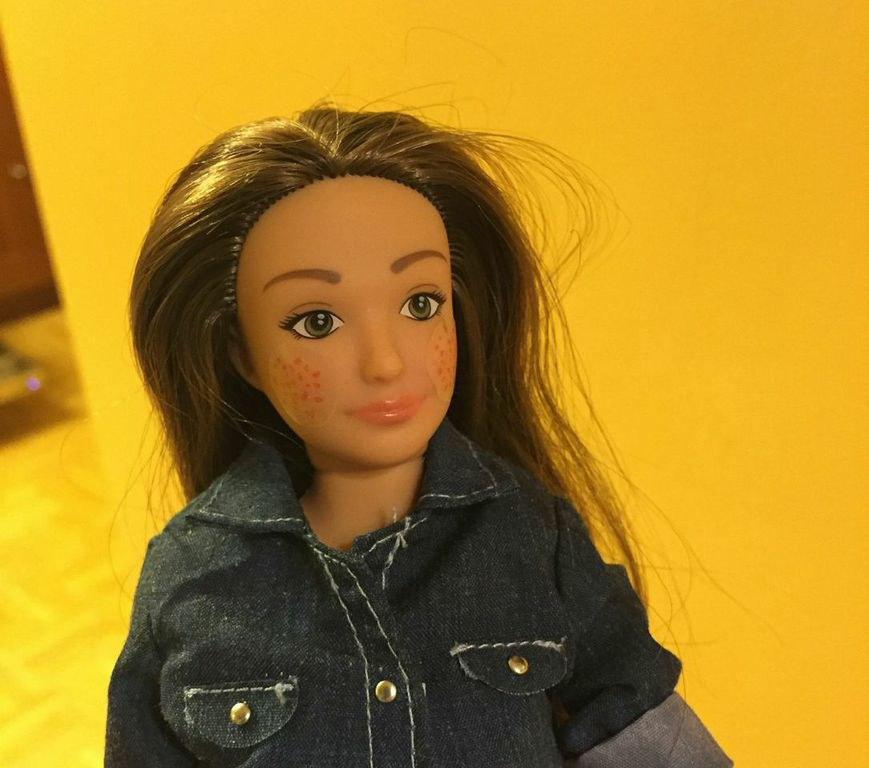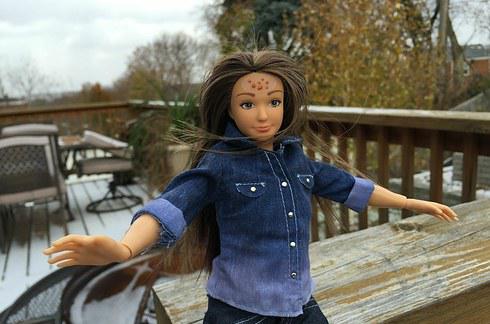Soon, kids will be able to trick out a “Normal Barbie” with stretch marks, acne, and bruises. Designer Nickolay Lamm has created an 11-inch doll of typical female proportions: no ginormous boobs stuck on a teeny frame atop permanently arched feet. For $6, you can also order a page of 38 reusable stickers, made of clear vinyl, which include—in addition to the stretch marks, contusions, and zits—cellulite, freckles, glasses, bandages, moles, stitches, scrapes, scars, and mosquito bites. The idea, Lamm explains on his website, is to give girls toys that reflect the lovable imperfections of their own bodies.
“Normal Barbie,” also known as Lammily, is “the first fashion doll made according to typical human body proportions to promote realistic beauty standards,” says the site. Since launching a crowd-funding crusade on Kickstarter back in March, Lamm has received more than 19,000 pre-orders from 13,621 backers, and a blizzard of positive press. He used measurements deemed average for a 19-year-old woman by the Centers for Disease Control to sculpt his prototype, whose epigones now cost $25 (not bad!) and will be shipped out to purchasers starting on Nov. 28. (The stickers won’t be available until January.)

Nickolay Lamm
I like the black humor and whimsical Schadenfreude of kids gleefully pasting acne, surgical scars, and cellulite beads all over their “Barbies.” Doll play often has a whiff of latent sadism—think of the terrible haircuts and decapitations children inflict on their figurines—and these toys lay it bare. The dolls also reflect the idea that cultural products should be relatable—that kids should be able to customize their playthings and experiences, because their individuality is special and worth nurturing. In this case, such solicitous tailoring seems like a positive step. We want girls to see themselves mirrored in their role models and fantasy characters. We want them to know that their particular scrapes and bumps and puberty stretch marks are normal—beautiful, even. (And indeed, if it’s individuality that makes someone precious, then flawless Barbie has nothing on scabbed-up Lammily.)

Nickolay Lamm
You could argue that the Lammily doll is political correctness and gushy self-acceptance run amok. But I think she represents something better than that, if also more complicated. Beauty remains a real perk for women, a sort of cloud of privilege you might not realize you have. When you’ve got it, you can always fall back on it, usually unconsciously, no matter how terrible everything else is. When you don’t have it, you have to focus on stuff that actually matters. (Which is not to say that gorgeous women do not prioritize meaningful issues, only that they aren’t forced to.) Anyway, this recalibration is hard but worth it. And the dream is that one day, the pretty people and the not-pretty people will be judged by the same standard. But until then, maybe we need average-looking dolls. To get people to pay attention to the right things. To not grow distracted by the glittering object with the perfect unbroken skin and the minuscule arms.
I wish I could appreciate the old Barbie’s appearance the way I appreciate someone’s athleticism or wit. But it’s hard to value looks in a pure, uncomplicated fashion when they’ve assumed such outsized importance in people’s minds. Maybe—until we’ve done a better job dethroning beauty as the be-all-end-all—these new dolls can direct girls’ fantasies in other, healthier directions.
